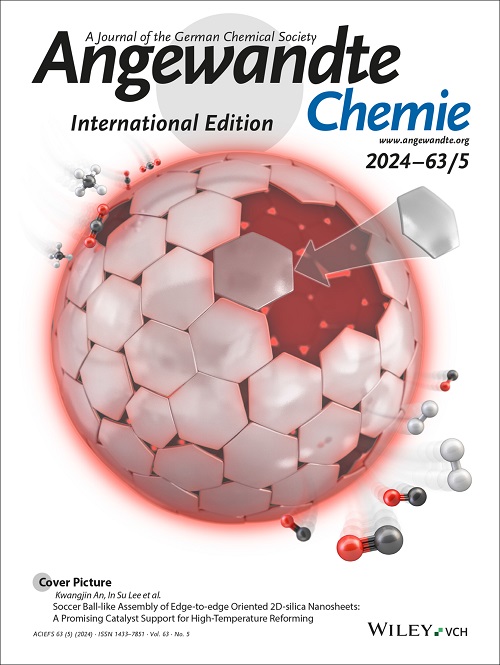Subtle Modifications in Interface Configurations of Iron/Cobalt Phthalocyanine-based Electrocatalysts Determine Molecular CO2 Reduction Activities
IF 16.1
1区 化学
Q1 CHEMISTRY, MULTIDISCIPLINARY
引用次数: 0
Abstract
Strain engineering has emerged as a powerful approach in steering the material properties. However, the improved catalytic activity remains poorly understood. Here we report that subtle changes in molecular configurations can profoundly affect, conducively or adversely, the catalytic selectivity and product turnover frequencies (TOFs) of CO2RR. Specifically, introducing molecular curvature in cobalt tetraaminophthalocyanine improves the multielectron CO2RR activity by favorable *CO hydrogenation, attaining methanol Faradaic efficiency up to 52%. In stark contrast, strained iron phthalocyanine exacerbates *CO poisoning, leading to a decreased TOFCO by over 50% at -0.5 VRHE and a rapid current decay. The uniform dispersion is crucial for optimizing electron transfer, while activity is distinctly sensitive to local atomic environment around the active sites. Specifically, local strain either enhances binding to intermediates or poisons the catalytic sites. Our comprehensive analysis elucidates the intricate relationship between molecular structure and CO2RR activities, offering insights into designing efficient heterogeneous molecular interfaces.铁/钴酞菁基电催化剂界面配置的微妙变化决定二氧化碳分子还原活性
应变工程已成为指导材料特性的有力方法。然而,人们对催化活性的改善仍然知之甚少。在此,我们报告了分子构型的微妙变化会对 CO2RR 的催化选择性和产物周转频率(TOF)产生深远影响,无论是有利还是不利。具体来说,在四氨基酞菁钴中引入分子曲率可通过有利的*CO氢化提高多电子 CO2RR 活性,使甲醇法拉第效率高达 52%。与此形成鲜明对比的是,有应变的铁酞菁会加剧 *CO 中毒,导致 -0.5 VRHE 时 TOFCO 下降 50%以上,电流迅速衰减。均匀分散对优化电子转移至关重要,而活性则对活性位点周围的局部原子环境非常敏感。具体来说,局部应变要么会增强与中间产物的结合,要么会毒害催化位点。我们的综合分析阐明了分子结构与 CO2RR 活性之间错综复杂的关系,为设计高效的异质分子界面提供了启示。
本文章由计算机程序翻译,如有差异,请以英文原文为准。
求助全文
约1分钟内获得全文
求助全文
来源期刊
CiteScore
26.60
自引率
6.60%
发文量
3549
审稿时长
1.5 months
期刊介绍:
Angewandte Chemie, a journal of the German Chemical Society (GDCh), maintains a leading position among scholarly journals in general chemistry with an impressive Impact Factor of 16.6 (2022 Journal Citation Reports, Clarivate, 2023). Published weekly in a reader-friendly format, it features new articles almost every day. Established in 1887, Angewandte Chemie is a prominent chemistry journal, offering a dynamic blend of Review-type articles, Highlights, Communications, and Research Articles on a weekly basis, making it unique in the field.

 求助内容:
求助内容: 应助结果提醒方式:
应助结果提醒方式:


